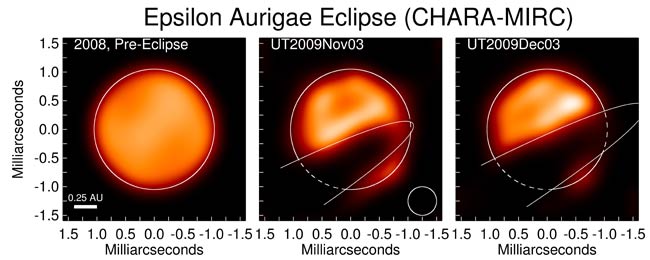Secrets of Shady Star System Revealed

New images of two strange stars, where one passes in frontof the other to block its light periodically as seen from Earth, are beginningto give up the secrets of this puzzling stellar pair.
The star system, called Epsilon Aurigae, experiences theeclipse once every 27 years. For the first time, scientists have directlyimaged the dark companion that blocks its companion?s light.
Astronomers have been watching this pair of stars since the1800s. Over time, they noticed that the main star appears dimmer than it shouldbe, given its mass, and that its brightness dips even more for longer than ayear every few decades. The system lies about 2,000 light-years from Earth (a light-yearis the distance light can travel in one year).
Scientists had previously surmised that the bright star hasa hidden companion that was blocking its light, and the new observationsconfirm that.
"Seeing is believing," said study leader JohnMonnier, an astronomer at the University of Michigan.
Astronomers have also wondered why this starcompanion was so difficult to see.
Some researchers have suggested that it is a faint star witha thick cloud of dust orbiting it, obscuring some of its light. But the alignmentof the cloud, the star, its companion, and Earth would have to be just rightfor this to be the case.
Get the Space.com Newsletter
Breaking space news, the latest updates on rocket launches, skywatching events and more!
And indeed, the new data support this idea.
"This really shows that the basic paradigm was right,despite the slim probability," Monnier said. "It kind of blows mymind that we could capture this. There's no other system like this known. Ontop of that, it seems to be in a rare phase of stellar life. And it happens tobe so close to us. It's extremely fortuitous."
The astronomers used the Michigan Infra-Red Combinerinstrument to combine the light entering four telescopes at the CHARA array atGeorgia State University. The effect is a virtual telescope that is much largerthan its four constituents.
The researchers detail their findings in the April 8 issueof the journal Nature.
- Top 10 Star Mysteries
- New Hubble Photos of Stars and Galaxies
- FirstStars Might Have Had Twins
Join our Space Forums to keep talking space on the latest missions, night sky and more! And if you have a news tip, correction or comment, let us know at: community@space.com.

Clara Moskowitz is a science and space writer who joined the Space.com team in 2008 and served as Assistant Managing Editor from 2011 to 2013. Clara has a bachelor's degree in astronomy and physics from Wesleyan University, and a graduate certificate in science writing from the University of California, Santa Cruz. She covers everything from astronomy to human spaceflight and once aced a NASTAR suborbital spaceflight training program for space missions. Clara is currently Associate Editor of Scientific American. To see her latest project is, follow Clara on Twitter.









